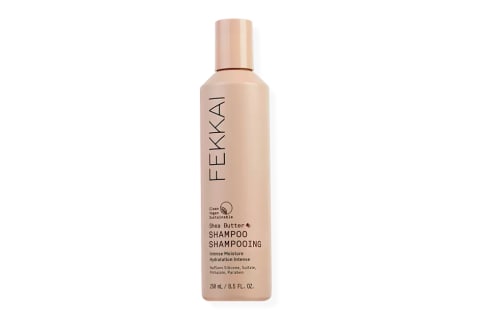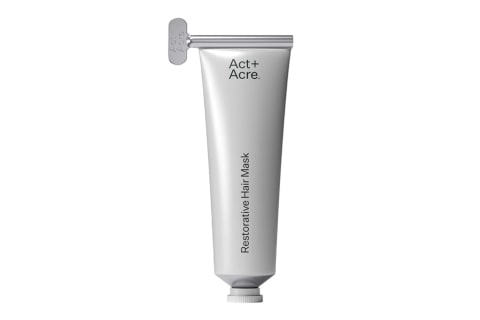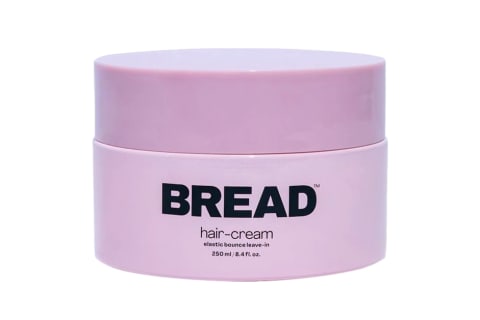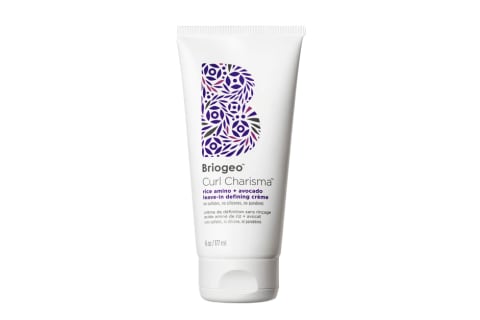Advertisement
Shea Butter For Hair: Uses, Tips & A DIY Recipe

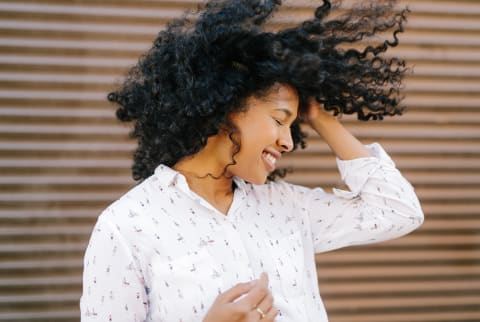
While modern technology has provided us with plenty of high-tech hair care products, some of the most effective ingredients are those that have been used for centuries. One example is the hair- and skin-loving shea butter.
You've probably heard of this ingredient before but might not be familiar with just how powerful this all-natural hydrator really is, especially for the strands. To follow, the many benefits and how to whip up your very own hair recovery treatment.
What is shea butter?
Shea butter is made from the fat extracted from the nuts of the Shea Tree, a plant native to West Africa (almost all of the shea butter used today still comes from this region). It, of course, has long been a staple for those with curly, coily, and kinky hair as it has tons of uses (not to mention: It's a great body hydrator, too).
Shea butter falls into a moisturizer category called an emollient, meaning it deeply nourishes the hair to create a softer, smoother texture. In fact, trichologist and founder of Colour Collective Kerry Yates calls it, "A super emollient," because it's rich in vitamins A and C as well, both of which contribute to bouncier hair.
Just taking a quick peek at the nutrient profile of the butter1 will show you just how healing it is: It contains several types of fatty acids that are naturally found to balance skin like linoleic, palmitic, stearic, and oleic fatty acids; it also contains vitamin E, a potent and oil-soluble antioxidant that can help fight free-radical damage; and triglycerides, which are known to help condition both skin and hair.
Hair benefits of shea butter
If you add this ingredient to your hair care routine, you can expect the following effects to take place on your locks:
- Increased hydration: "Anyone with dry hair could benefit from using shea butter, especially on the mid-lengths and ends of the hair," Yates says. It's particularly beneficial for curly and coily hair types, Yates adds, because of the increased dryness that comes with having more textured hair.
- Tamed frizz: Frizz is often caused by split ends and broken strands. While you can't fully heal damaged hair, you can mask the splits via emollients like shea butter. "In its natural form, you can apply it directly to the ends of hair, as it acts like a conditioner and can help prevent split ends and reduce breakage," says hairstylist Miko Branch, founder of Miss Jessie's.
- Soothed scalp: Yates also notes that shea butter is, "Brilliant for the scalp to help alleviate dry, swollen skin." We'll dive deeper into how to apply this ingredient to the scalp in a bit.
- Conditioned strands: You've probably heard of (or used) shea butter conditioner before, and there's a reason for that. Not only does shea butter deeply moisturize the hair as mentioned above, but it also helps to lock in moisture for longer, keeping your strands silky between washes.
- Protected skin and hair: Remember when we mentioned that shea butter is rich in vitamin E? Well, this factor makes shea butter a wonderful protector of your skin and hair, acting like a shield against free radicals from the environment that cause oxidative damage.
- Natural heat protector: "Shea butter can also lightly protect hair from any heat damage," Branch agrees. Apply a thin layer of the ingredient on your hair when damp before taking a blow dryer or diffuser to your strands.
Other shea butter benefits
We can't talk about shea butter for hair without mentioning the many other benefits of this multiuse ingredient. Here are a few things to remember:
- It conditions lips
- Serves as a great full-body moisturizer
- Replenishes moisture in dry skin
- Nourishes the cuticles
- Soothes irritation
What hair types benefit from shea butter?
As we noted above, shea butter is ideal for curly and coily hair types. Anyone experiencing increased hair dryness or unusually rough texture will also benefit from applying the rich moisturizer to their strands.
However, "Fine hair users need to use it sparingly as too much can actually weigh the hair down, which is not ideal," Yates says. This doesn't mean people with fine hair shouldn't use the ingredient at all; they instead should opt for it in a lightweight blend rather than on its own.
Can shea butter grow hair?
Given the amount of natural hair growth remedies out there, it's only fair to wonder if this hydrator can do the same. While shea butter does condition the hair you already have, it won't necessarily stimulate the scalp or encourage the hair follicle to grow at a quicker rate.
That being said, it can help you in your hair growth journey. In order to achieve longer hair, you'll need to protect your strands from split ends, damage, and breakage—all of which shea butter can help with.
Whipped shea butter + how to make it
Shea butter is quite dense on its own, which is why it's commonly whipped up with other hydrating ingredients like botanical oils. You'll want to follow that same method to make your own hair mask meets body butter DIY product—here's how the process is broken down.
DIY whipped shea butter instructions:
- Take your raw shea butter (unrefined or refined are fine) like this option from Ra Cosmetics. Place it in a medium metal bowl.
- In a large pot, bring water to a boil. Place your bowl of shea butter onto the pot so the shea is heated from the steam of the boiling water.
- Once melted, remove from the pot, and add a generous tablespoon scoop of coconut oil. You can play around with proportions.
- Using a stand mixer—yes like you might with cooking—begin whipping the mixture together. You can take this process 5 minutes at a time, checking the consistency throughout. Eventually, after about 15 to 20 minutes of this, you'll get a light, fluffy consistency.
- Store your butter in a cool, dark place.
If you're going to use the whipped butter on its own as a hair mask, keep the following tips in mind:
- For those with oily scalps or thin hair, stop at about mid-shaft.
- If you have denser hair and tend to have an itchy scalp, you can work the ingredient all the way up to the root—even working it in the skin.
- You can leave the mask on for anywhere from 10 to 30 minutes before rinsing the butter out.
- For deep hydration, wrap your hair in a plastic cap and let it sit overnight.
How to use shea butter for hair
Now if the DIY method isn't for you, don't worry. Shea butter is found in plenty of hair care products on the market today, especially in the following categories.
Hydrating shampoo
Shampoo takes a toll on your hair, especially if you're a frequent washer. To mitigate some of that dryness, look for shea butter in your shampoo. This rich emollient is often blended with surfactants to ensure the cleansing function doesn't over-strip your hair.
If you have dry or coarse hair, make shea butter a regular ingredient in your cleansing routine. Otherwise, use your hydrating shampoo seasonally or whenever your hair craves a tad more moisture.
Conditioners & masks
This step is where shea butter truly shines: hair masks and conditioners. Use your raw shea butter as a hair mask or look for shea in your next product. Again, feel free to rotate in a heavier conditioner or mask rich in shea when your strands need it or use it every wash if your hair is on the drier side.
Leave-ins & styling creams
You can even use shea butter in post-wash products like leave-in conditioners or styling creams. Especially for those with curly strands, the smoothing powers of shea will help enhance your natural curl or coil shape after your wash or between washes.
As mentioned before, shea butter will help protect your hair from heat as well, making it a great addition to any leave-in product you use before diffusing, blow drying, or styling your hair with hot tools.
FAQ
Is shea butter good for your hair?
Yes, shea butter is good for your hair. Shea butter falls into a moisturizer category called an emollient, meaning it deeply nourishes the hair to create a softer, smoother texture. In fact, Yates calls it, "A super emollient," because it's rich in vitamins A and C as well, both of which contribute to bouncier hair.
How long do you leave shea butter in your hair?
If you're using whipped shea butter as a hair mask, leave it in for anywhere from 10 to 30 minutes before rinsing the butter out. For a deep conditioning treatment, leave it in overnight.
Do you put shea butter on wet or dry hair?
You can apply shea butter to both wet and dry hair, but you may have an easier time working it through your strands if your hair is damp, especially if you're using raw whipped shea butter alone.
The takeaway
Shea butter is a great ingredient to hydrate, smooth, and protect your hair. This rich moisturizer is best suited for curly and coily hair types but will benefit anyone prone to dryness or coarse texture as well. You can whip up your own, shop shea butter hair care products, and even use it on the body for its many skin benefits.


